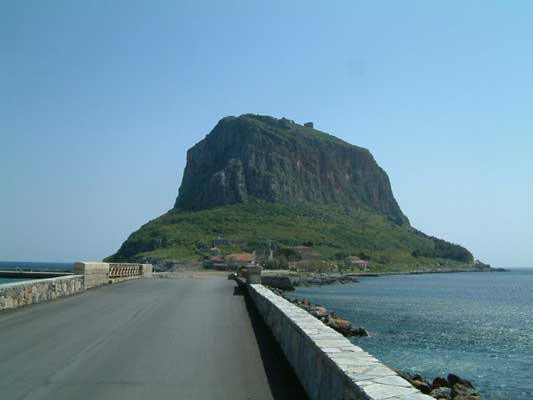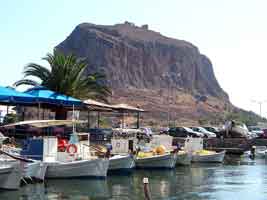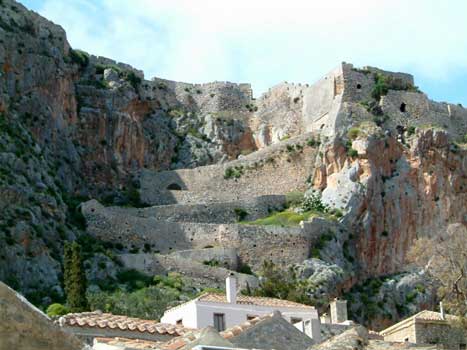- http://www.monemvasia.de (also in German)
- History and Travel Information
Monemvasia (Greek: Μονεμβασία), or Malvasy, is a medieval fortress with an adjacent town, located on a small peninsula off the east coast of the Peloponnese in the Greek prefecture of Laconia. Remains include the defensive structures, the small adjacent town and Byzantine churches. Its name derives from two Greek words, monem and emvasia, meaning "single entrance". Many of the streets are narrow and are only fit for pedestrians. The bay of Palaia Monemvasia is found in the north. Monemvasia's nickname is the Gibraltar of the East. The main industry and export of Monemvasia is the production of Malmsey, a kind of red wine. The rock is 300 m tall and 1.8 km long. The village is situated on the southeastern side of the rock, which overlooks the Palaia Monemvasia bay. A small hamlet with about 10 houses lies to the northwest. A field of grass covers the northwest and top, accessed by a rocky, zig-zagging pathway. The fortress lies on the north side of the colorful rock, which ranges from grey to peach melon and pink. Nearest places Agios Ioannis in Monemvasia Communes Monemvasia
Monemvasia can be seen in the background Monemvasia Google Earth Historical population
From 1981 to 1991, the village had a huge decline in population, one of the places that lost population in Laconia. History
Middle Ages The founding of the town and fortress of Monemvasia most probably occurred in the 6th Century AD. The town was founded in 583 by people seeking refuge from the Slavic and the Avaric invasion of Greece. From the 10th Century AD, the town developed into an important trade and maritime center. The fortress withstood the Arab and Norman invasions and conquests in 1147. Cornfields that fed up to 30 men were grown inside the fortress. It was a Byzantine town that existed continuously under the domain of the Empire until the 15th Century, when the Empire fell. It was successively governed by Venetians and Ottomans in intervals: Venetian: (1460 - 1540) The commercial importance of the town continued until the Orlov Revolt (1770) in the Russo-Turkish War, which saw its importance decline severely. Modern times
The town of Monemvasia as it appears today
The town was liberated from Ottoman rule on August 1, 1821, during the Greek War of Independence.
Citadel The citadel has been uninhabited since 1920. In 1971, Monemvasia became linked with the rest of the outside world through a bridge on the western side that connects to GR-86. In more recent history, the town has seen a resurgence in importance with increasing numbers of tourists visiting the site and the region. The medieval buildings have been restored, many of them converted to hotels. Places of interest
Hagia Sophia Church build end of 12th century under the order of the Byzantine Emperor Andronicus, transformed into a cathedral and into a Mosque, the frescoes covered with lime [Source] The Church of Hagia Sophia Other Monemvasia had a school, but has a church and a square (plateia). There are no banks in the area. Monemvasia also has hotels, including the Flower Hotel. Persons Yannis Ritsos (Γιάννης Ρίτσος) (1.5.1909 Monemvasia – 12.11.1990) Athens) “αυτές οι καρδιές δε βολεύονται παρά μόνο στο δίκιο (these hearts do not compromise but in justice)” Romiosyni (Lenin Order 1977) Division of the municipality of Monemvasia Monemvasia / Τ.δ. Μονεμβασίας [ 1.405 ]
Angelona / Τ.δ. Αγγελώνας -- η Αγγελώνα [ 518 ] Agios Dimitrios Monemvasias / Τ.δ. Αγίου Δημητρίου Μονεμβασίας [ 317 ]
Agios Ioannis Epidavrou Limiras / Τ.δ. Αγίου Ιωάννου Επιδαύρου Λιμήρας -- ο [ 557 ] Agios Nikolaso Monemvasias / Τ.δ. Αγίου Νικολάου Μονεμβασίας -- ο Άγιος Νικόλαος [ 188 ] Velies / Τ.δ. Βελιών -- οι [ 494 ] Elliniko / Τ.δ. Ελληνικού [ 315 ]
Lira / Τ.δ. Λιρών [ 280 ]
Nomia / Τ.δ. Νομίων [ 367 ]
Talanta / Τ.δ. Ταλάντων [ 219 ]
 |
|
|||||||||||||||||||||||||||||||||||||||||||||||||||||











